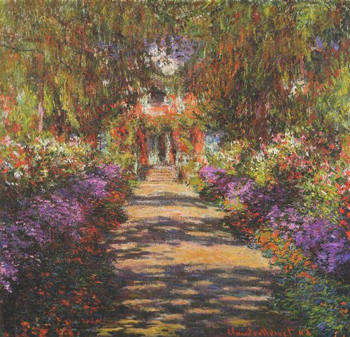| Search Art Prints | ||||||||||||||||||||
| Search Artists | ||||||||||||||||||||

|
||||||||||||||||||||
|
|
|||||||||||||||||||

Main Path through the Garden at Givernyalso known as Une Allée du jardin de Monet, Giverny

|
Of all the subjects Monet painted, the multitude of locales his garden at Giverny provided are the most famous. The garden's path leading up to Monet's house received less attention than the Japanese bridge or the water lilies, however, and for good reason: Monet didn't paint it nearly as much.
Monet's largest flurry of paintings of the path resulted from inconvenience. At one point, Monet commissioned some heavy-duty landscape work to enlarge the lily pond. This included redirecting a minor branch of a nearby river and was a massive undertaking, requiring months of work. The lily pond was completely disrupted during this time, and Monet had to look elsewhere for subjects to paint. The path, among other things, received attention.
Another notable factor of the period in which this painting was produced was that at the time, Monet was completing studies he had begun in London and Lavacort. It was all indoor, studio-bound work, very unusual for the painter, especially at that point in his career. Indeed, up until that point, he claimed to work exclusively outdoors, but had to concede that that wasn't truly the case.
These breaks in Monet's routine show up clearly in Garden Path at Giverny, most notably in its spatial construction. The painting has far more depth than the likes of Monet's water lily paintings; it is closer to the likes of his more open landscape paintings. Still, the space within the frame is cramped. The trees, shrubs, and flowers almost form walls and a ceiling. The house comprises what would be the far wall. Even though it is out of doors, the painting seems confined within a room, although the organic and verdant mood of the garden is not sacrificed.
The colors are notable too. Purples and reds leap off the canvas in close proximity to one another. The warm glow of midday sun illuminates the whole scene. This too, is relatively unusual for Monet's Giverny paintings, which were more often painted in softer light and in far more muted tones.











